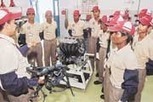Oct 4 2012
Deming’s Point 6 of 14 – Institute Training on the Job
Note: The teacher in this picture is Mustapha Kemal Atatürk, founder and president of the Turkish Republic, in 1928. Until then, Turkish had been written in the Arabic script. Atatürk crisscrossed the country to personally introduce the Latin alphabet to notables in every town. At the end of his presentation, they had to choose a last name and write it on the blackboard in the new script. It may not have been on-the-job training, but it certainly is an illustration of training and of committed leadership. And it worked: 84 years later, Turkish is still written in the Latin alphabet.
Deming’s full, terse statement of his 6th Point is as follows:
“Institute training on the job”
“Institute” is stronger language that just “implement.” It is not just about making something happen, but turning it into an institution. In the language of the 1980s, “on-the-job training” was synonymous with “sink or swim”: as a rookie engineer, you were given projects, and it was up to you to figure out how to carry them out. Given that you had had your fill of classes in college, you didn’t mind. Production line operators received some mandatory orientations on things like safety gears, but relied on colleagues to figure out how to do their work. So, what was Deming talking about?
Deming’s elaboration on Point 6 actually drops the “on-the-job” and is entitled just “Institute training.” In it, explains that it is about “the foundations of training for the management and for new employees,” as opposed to continuing education. Regarding management, he points out that Japanese managers “start their careers with a long internship (4 to 12 years) on the factory floor and in other duties in the company,” implying both that it is systematic in Japan, and not done anywhere else. I once worked with a Purchasing manager in a major Japanese company who had five spent years in Design Engineering (See Point 4), and this was part of a number of rotations preparing him for senior management positions. However, it was not systematic, in that not all professional employees went through this process.
This practice is also predicated on long-term, committed employer-employee relationships. It trains managers who know in depth how the company works and have personal ties to many of its departments, but are not necessarily at the top level of expertise in any of their specialties, and it does more to enhance their value to the company than their marketability outside of it. Similar practices are also found outside of Japan, in companies like Boeing, GM, or Unilever, for young employees identified as having “executive potential” (See Alternatives to Rank-and-Yank in Evaluating People). In Italy, I had the opportunity to work with a production supervisor in a frozen foods plant who was a young German engineer in such a program. The parameters and the management of these programs matter. They may degenerate, for example, if the time spent in each position is too short and if participants are rewarded for not making waves.
Here again, Deming is at odds with Drucker. The rotation of managers to be seasoned in the specifics of the company’s business before being promoted is contrary to Drucker’s concept of a professional manager who can run any business, and more in line with the practices of the military. When, at the end of The Practice of Management, Drucker discusses the preparation of tomorrow’s managers, which he sees as a combination of a “liberal education for use,” centered on classics and on a “basic understanding of science and scientific method,” supplemented by continuing education in advanced techniques of management. In his view, managers need to respect technical workmanship in the activity of the company, but they don’t need to possess this workmanship themselves, and their generic management skills are transferable across industries. At Apple, Steve Jobs would probably have agreed with Deming; John Sculley, with Drucker.
Deming says little on how shop floor operators should actually be trained, and makes no reference to Training-Within-Industry (TWI), a program we would have expected him to be familiar with as a development that was contemporary to his own work in World War II, but a Google search for “Deming +TWI” does not match any document. He bemoans companies’ failure to use people’s abilities but does not explain how training, on the job or otherwise, can remedy this.
Deming also says that training should be focused on the customer’s needs, which, influenced by TQM, we may interpret as meaning the next process. When Deming writes “customer,” however, he does not mean it metaphorically but literally. He is actually thinking of the real customer, the one who pays and has the option to buy elsewhere. In other words, training must relate the work done at any workstation to the experience of the end user of the finished product. The farther upstream from final assembly, the more remote the connection and the more challenging it is to communicate, but the more understanding an operator has of the effect of the work, the stronger the motivation to do it well.
Even in the best companies today, much of the initial training of operators is done off-line rather than on the job. The basic employee orientation on company procedures or personal protection equipment is, of course, done offline, but so is a major part of the work itself. Machinists learn the basics of CNC turning with tabletop lathes that carve wax cylinders before moving on to actual machines, and assembly teams learn the basics of the Kanban system through simulation games.


Mar 18 2013
Chrysler’s training academy hands-on (With Video) | the Windsor Star
See on Scoop.it – lean manufacturing

More details about Chrysler’s training academy.
See on blogs.windsorstar.com
Share this:
Like this:
By Michel Baudin • Press clippings 0 • Tags: Chrysler, Training, WCM